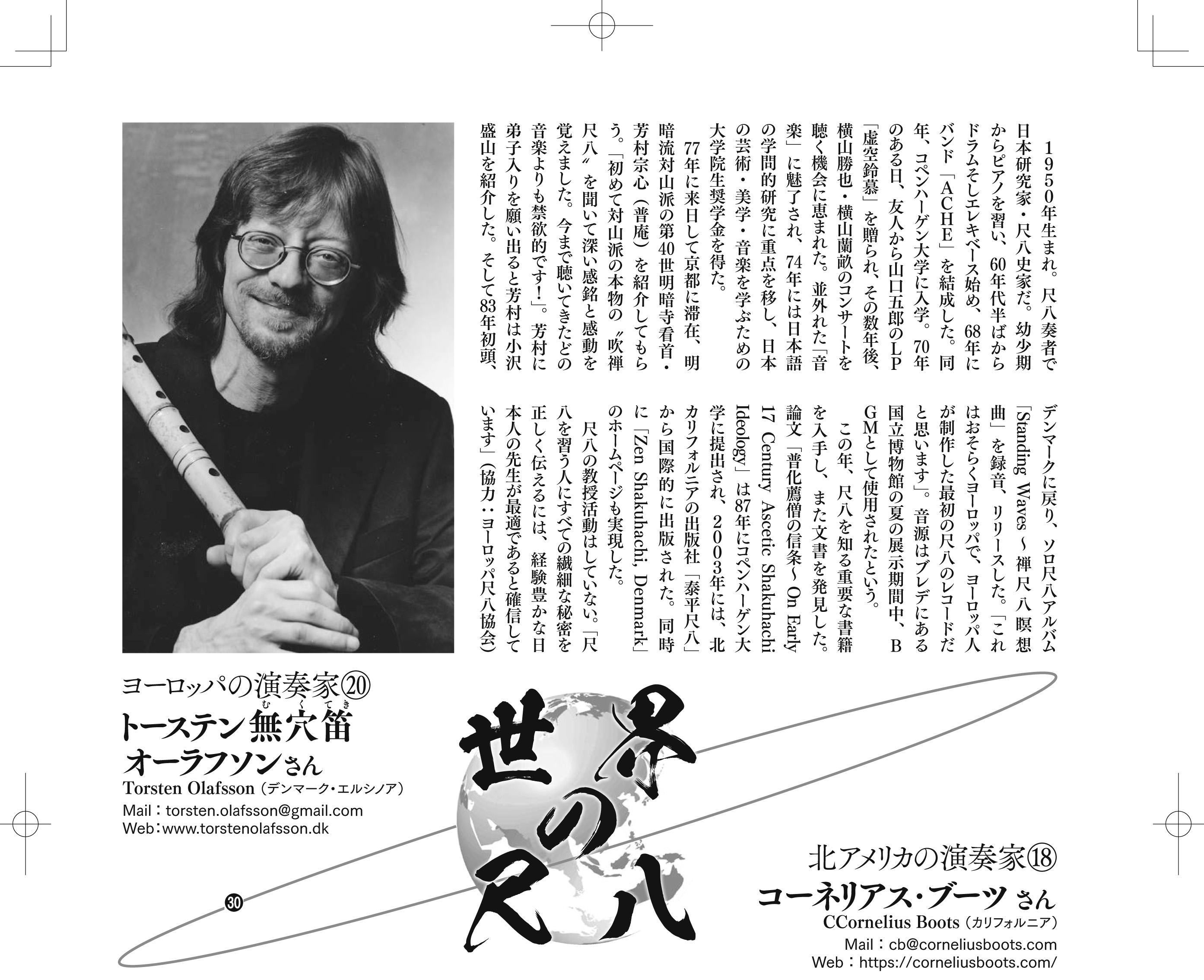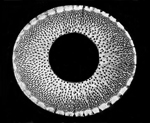|
Torsten Olafsson Profile Featured in the Music Magazine
Hōgaku Journal Vol. 430, Nov., 2022


Hōgaku Journal Vol. 430 page 39 - Hōgaku Journal Vol. 430, cover front
TORSTEN 'Mukuteki' OLAFSSON
Born in 1950. Shakuhachi player, Japanologist, and Shakuhachi Historian.
Learned piano from the early childhood, started playing drums and electric bass in the mid-60s, and formed the band "ACHE" in 1968.
In the same year, [Olafsson] enrolled at the University of Copenhagen.
One day, in 1970, a friend gave [Olafsson] Yamaguchi Gorō's LP ‘Kokū reibo’ as a present, and a few years later,
he was enlightened by listening to concerts with Yokoyama Katsuya and Yokoyama Ranpo [in Copenhagen].
Fascinated by that extraordinary "music", in 1974 he shifted his focus to the academic study of the Japanese language and acquired a graduate student scholarship
to study Japanese arts, aesthetics and music [in Kyōto].
In 1977, [Olafsson] came to stay in Kyōto and was introduced to Yoshimura Sōshin (Fuan), the 40th ‘kansu’ of the Myōan Temple
and [head of] the Taizan Branch of the Myōan [Shakuhachi] Tradition.
“Hearing the genuine ‘Suizen Shakuhachi’ of Taizan-ha for the very first time, it made a deep impression on me.
More ascetic than any music I'd ever heard!” [Olafsson explains].
When he asked Yoshimura to become a student, Yoshimura introduced him to Ozawa Seizan.
Then, in 1983, having returned to Denmark, [Olafsson] recorded and released the solo album “Standing Waves – Zen Shakuhachi Meditations”.
“That is probably the first shakuhachi record ever made by a European in Europe, I think” [says Olafsson].
The master tape was used as background music throughout the period of the [“Japan in Brede”] National Museum Summer exhibition [in 1983].
That same year, [Olafsson] purchased an important book and saw a document there. *)
In 1987, the thesis “The Fuke Komosō Credo. 17th Century Ascetic Shakuhachi Ideology” was submitted to the University in Copenhagen,
and in 2003, it was published internationally by the publishing company Taihei Shakuhachi in Northern California.
At the same time, the homepage “Zen Shakuhachi, Denmark” was also realized.
[Torsten Olafsson] does not teach the shakuhachi.
“For those who study how to play the shakuhachi, I am convinced that it is the best to learn all the delicate secrets from a native Japanese player” [Olafsson explains].
(Association: The European Shakuhachi Society)
European shakuhachi musician.
Torsten ’Mukuteki’ Olafsson
Denmark, Elsinore
Mail:torsten.olafsson@gmail.com
Web:www.torstenolafsson.dk
See the Japanese text that Hōgaku Journal printed displayed below.

Hōgaku Journal Vol. 430 page 39, top
The Japanese printed text as printed in Hōgaku Journal Vol. 430 on page 39
together with a presentation of Cornelius Boots:
1950年生まれ。尺八奏者で日本研究家・尺八史家だ。
幼少期からピアノを習い、60年代半ばからドラムそしエレキベース始め、
68年にバンド「ACHE」を結成した。
同年、コペンハーゲン大学に入学。
70年のある日、友人から山口五郎のLP
「虚空鈴慕」を贈られ、その数年後、
横山勝也・横山蘭畝のコンサートを
聴く機会に恵まれた。
並外れた「音楽」に魅了され、
74年には日本語の学問的研究に重点を移し、日本
の芸術・美学・音楽を学ぶための大学院生奨学金を得た。
77 年に来日して京都に滞在、明暗流対山派の第
40世明暗寺看首・芳村宗心(普庵)を紹介してもらう。
「初めて対山派の本物の“吹禅尺八〟を聞いて深い感銘と感動を覚えました。
今まで聴いてきたどの音楽よりも禁欲的です!」。
芳村に弟子入りを願い出ると芳村は小沢盛山を紹介した。
そして83年初頭、デンマークに戻り、ソロ尺八アルバム
「Standing Waves~ 禅尺八瞑想曲」を録音、リリースした。
「これはおそらくヨーロッパで、ヨーロッパ人が
制作した最初の尺八のレコードだと思います」。
音源はブレデにある国立博物館の夏の展示期間中、
BGMとして使用されたという。
この年、尺八を知る重要な書籍を入手し、また文書を発見した。
論文「普化薦僧の信条~On Early 17 Century Ascetic Shakuhachi Ideology」は 87年にコペンハーゲン大
学に提出され、2003年には、北 カリフォルニアの出版社「太平尺八」から国際的に出版された。
同時に"Zen Shakuhachi, Denmark" のホームページも実現した。
尺八の教授活動はしていない。
「尺八を習う人にすべての繊細な秘密を
正しく伝えるには、経験豊かな日本人の先生が
最適であると確信しています」
(協力:ヨーロッパ尺八協会)
ヨーロッパの演奏家⑳
トーステン無穴笛[むくてき]オーラフソンさん
Torsten Olafsson (デンマーク・エルシノア)
Mail:torsten.olafsson@gmail.com
Web:www.torstenolafsson.dk
Link to the English profile text originally prepared for the Hōgaku Journal:
Profile Status Update, Late 2022. Original Profile
submitted to Hōgaku Journal Vol. 430, Nov., 2022
Note *) The book title being referred to here is: Nakatsuka Chikuzen, 'Kinko-ryū shakuhachi shikan', Nihon Ongaku-sha, Tokyo, 1979, 600+ pages -
the most significant Japanese collection of historical shakuhachi sources and documentary evidence in existence.
The document in question is the 'Kaidō honsoku' hand scroll, dated 1628.
Read more here:
1628: The Kaidō honsoku Fuke-komosō Credo
Link to the Taihei Shakuhachi publishing house in Willits, N. California
|
|



